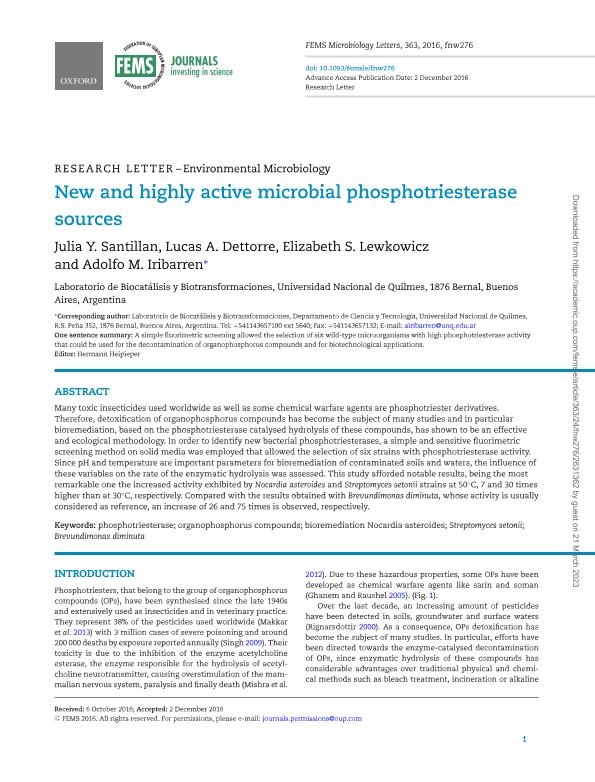Mostrar el registro sencillo del ítem
dc.contributor.author
Santillan, Julia Yamila

dc.contributor.author
Dettorre, Lucas Andrés

dc.contributor.author
Lewkowicz, Elizabeth Sandra

dc.contributor.author
Iribarren, Adolfo Marcelo

dc.date.available
2023-03-21T12:33:22Z
dc.date.issued
2012-12
dc.identifier.citation
Santillan, Julia Yamila; Dettorre, Lucas Andrés; Lewkowicz, Elizabeth Sandra; Iribarren, Adolfo Marcelo; New and highly active microbial phosphotriesterase sources; Wiley Blackwell Publishing, Inc; FEMS Microbiology Letters; 363; 24; 12-2012; 1-5
dc.identifier.issn
0378-1097
dc.identifier.uri
http://hdl.handle.net/11336/191152
dc.description.abstract
Many toxic insecticides used worldwide as well as some chemical warfare agents are phosphotriester derivatives. Therefore, detoxification of organophosphorus compounds has become the subject of many studies and in particular bioremediation, based on the phosphotriesterase catalysed hydrolysis of these compounds, has shown to be an effective and ecological methodology. In order to identify new bacterial phosphotriesterases, a simple and sensitive fluorimetric screening method on solid media was employed that allowed the selection of six strains with phosphotriesterase activity. Since pH and temperature are important parameters for bioremediation of contaminated soils and waters, the influence of these variables on the rate of the enzymatic hydrolysis was assessed. This study afforded notable results, being the most remarkable one the increased activity exhibited by Nocardia asteroides and Streptomyces setonii strains at 50°C, 7 and 30 times higher than at 30°C, respectively. Compared with the results obtained with Brevundimonas diminuta, whose activity is usually considered as reference, an increase of 26 and 75 times is observed, respectively.
dc.format
application/pdf
dc.language.iso
eng
dc.publisher
Wiley Blackwell Publishing, Inc

dc.rights
info:eu-repo/semantics/openAccess
dc.rights.uri
https://creativecommons.org/licenses/by-nc-sa/2.5/ar/
dc.subject
BIOREMEDIATION NOCARDIA ASTEROIDES
dc.subject
BREVUNDIMONAS DIMINUTA
dc.subject
ORGANOPHOSPHORUS COMPOUNDS
dc.subject
PHOSPHOTRIESTERASE
dc.subject
STREPTOMYCES SETONII
dc.subject.classification
Química Orgánica

dc.subject.classification
Ciencias Químicas

dc.subject.classification
CIENCIAS NATURALES Y EXACTAS

dc.title
New and highly active microbial phosphotriesterase sources
dc.type
info:eu-repo/semantics/article
dc.type
info:ar-repo/semantics/artículo
dc.type
info:eu-repo/semantics/publishedVersion
dc.date.updated
2023-03-20T14:47:53Z
dc.journal.volume
363
dc.journal.number
24
dc.journal.pagination
1-5
dc.journal.pais
Reino Unido

dc.journal.ciudad
Londres
dc.description.fil
Fil: Santillan, Julia Yamila. Universidad Nacional de Quilmes. Departamento de Ciencia y Tecnología. Área Química. Laboratorio de Biotransformaciones; Argentina. Consejo Nacional de Investigaciones Científicas y Técnicas; Argentina
dc.description.fil
Fil: Dettorre, Lucas Andrés. Universidad Nacional de Quilmes. Departamento de Ciencia y Tecnología; Argentina. Consejo Nacional de Investigaciones Científicas y Técnicas; Argentina
dc.description.fil
Fil: Lewkowicz, Elizabeth Sandra. Consejo Nacional de Investigaciones Científicas y Técnicas; Argentina. Universidad Nacional de Quilmes. Departamento de Ciencia y Tecnología. Área Química. Laboratorio de Biotransformaciones; Argentina
dc.description.fil
Fil: Iribarren, Adolfo Marcelo. Universidad Nacional de Quilmes. Departamento de Ciencia y Tecnología. Área Química. Laboratorio de Biotransformaciones; Argentina. Consejo Nacional de Investigaciones Científicas y Técnicas; Argentina
dc.journal.title
FEMS Microbiology Letters

dc.relation.alternativeid
info:eu-repo/semantics/altIdentifier/doi/http://dx.doi.org/10.1093/femsle/fnw276
Archivos asociados
